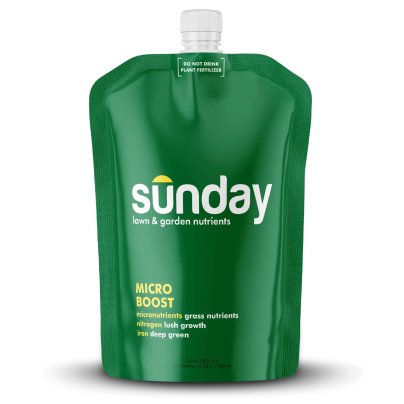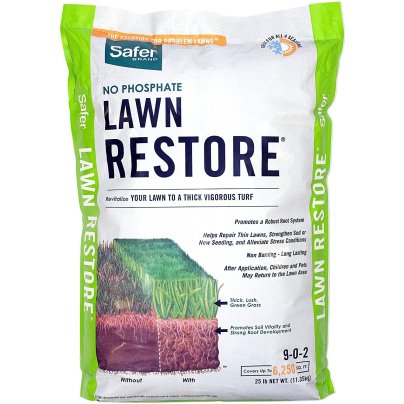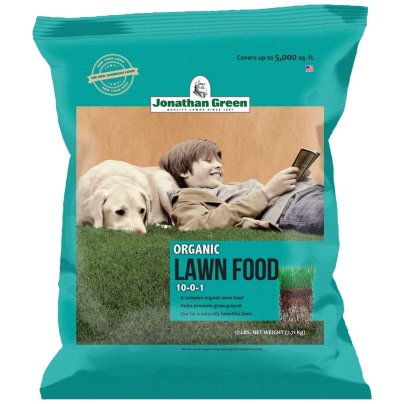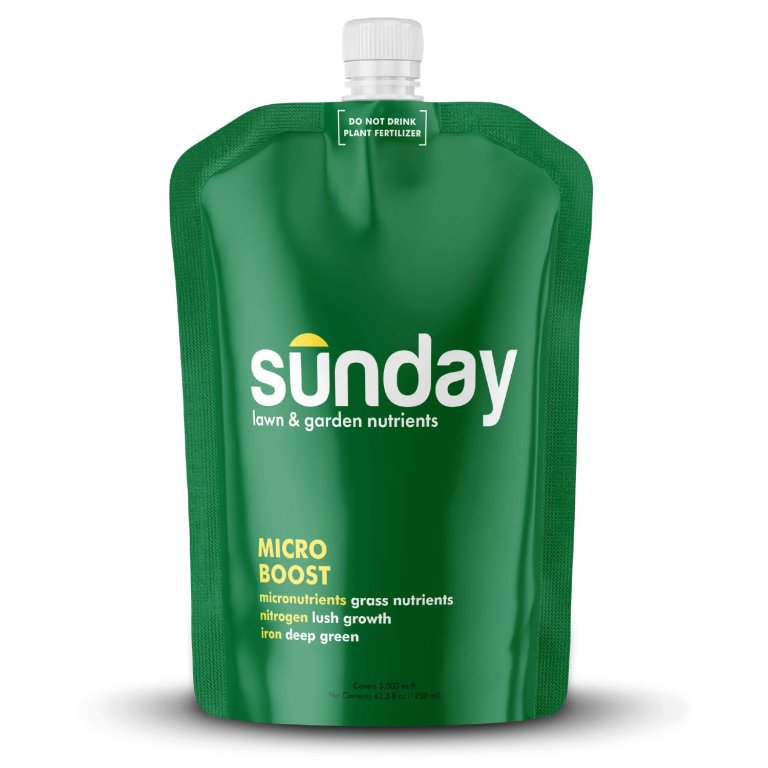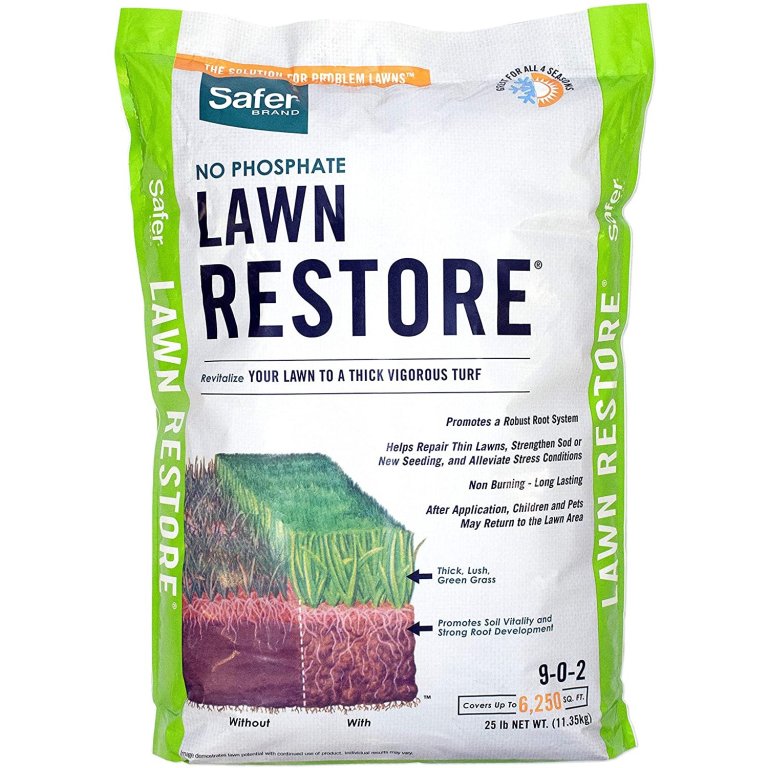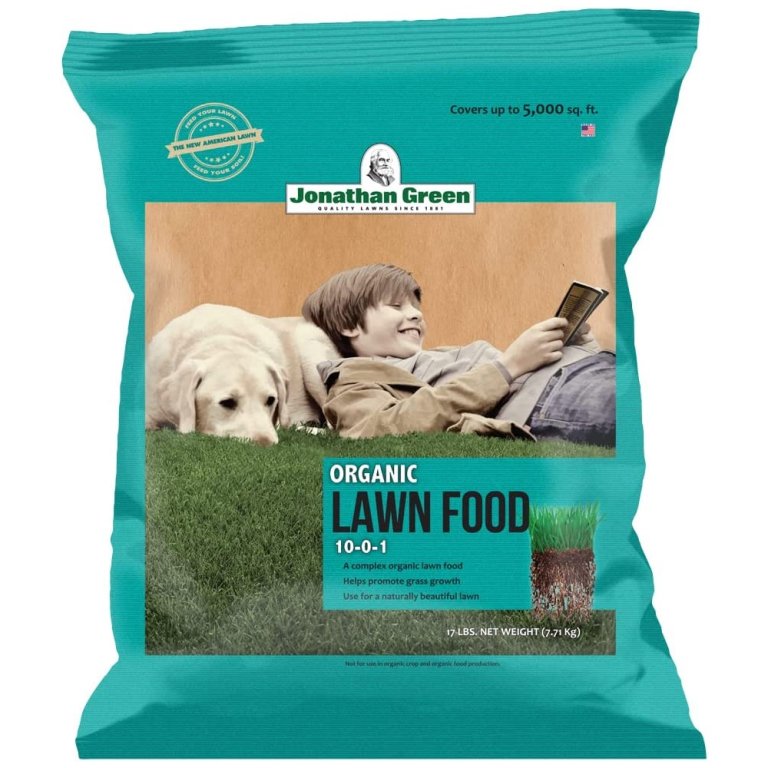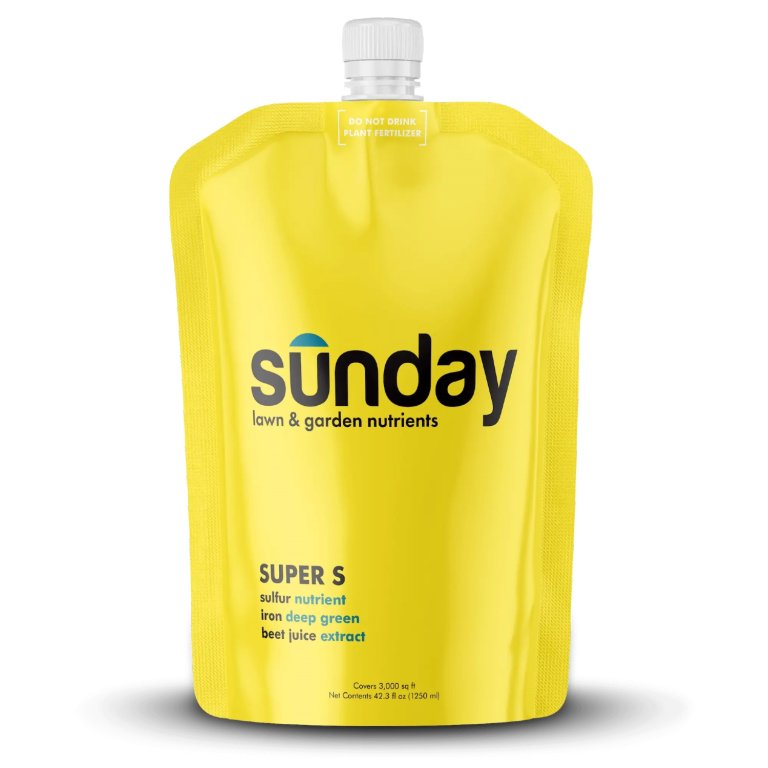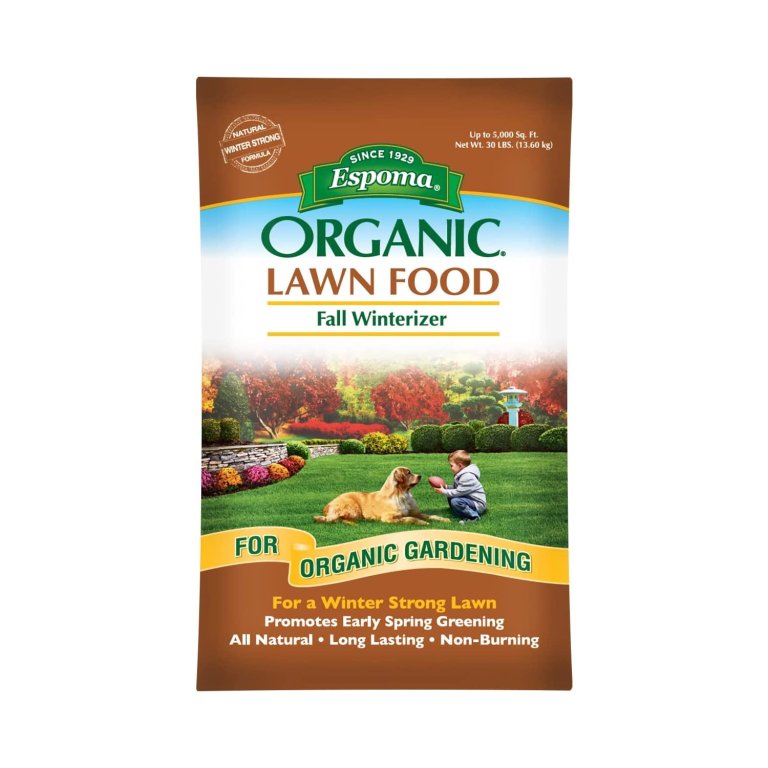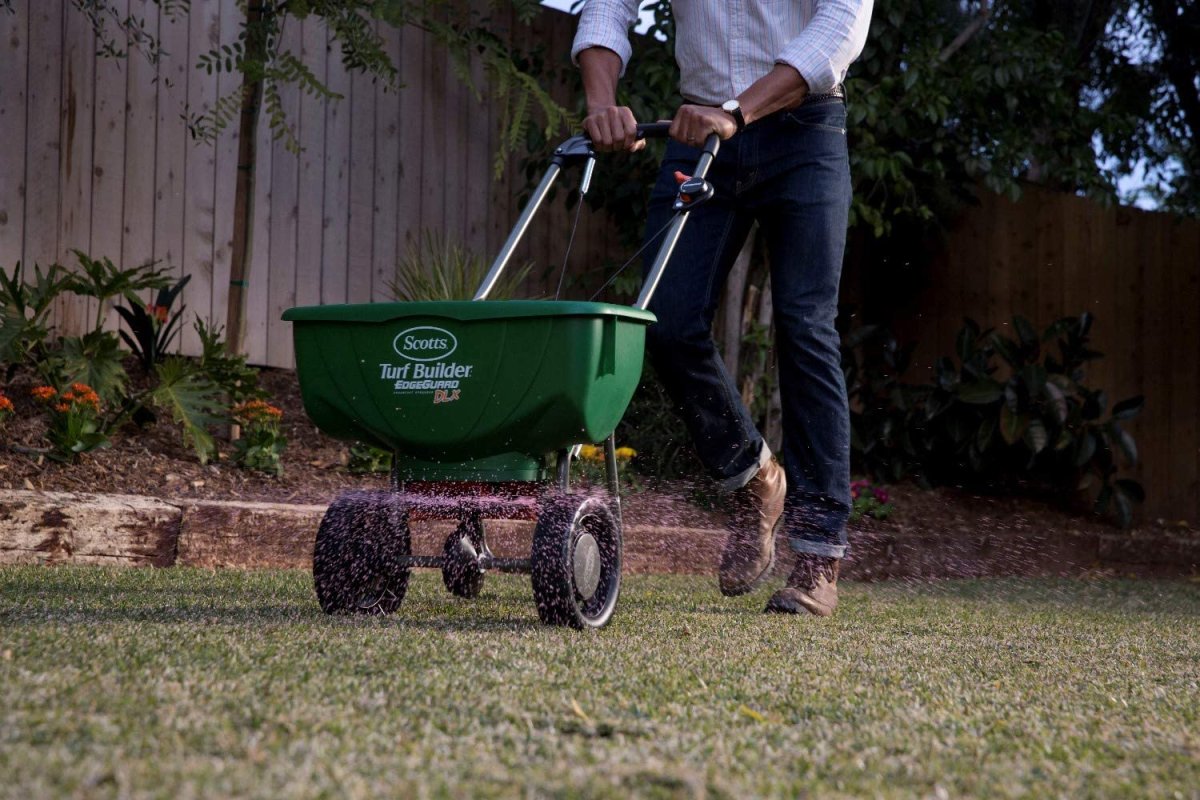
We may earn revenue from the products available on this page and participate in affiliate programs. Learn More ›
Slow growing and semi shade tolerant, centipede grass is known throughout the South as “the lazy man’s grass.” Growing from South Carolina to Florida and along the Gulf coast, it thrives with little fertilizer, requires less frequent mowing than other lawn grasses, and is well adapted to the heat and humidity of the southern states. Tolerant as it is, centipede grass does need a little bit of care. Providing the right fertilization program helps ensure that a centipede lawn grows dense and healthy.
Unlike other grasses, centipede grows best in soil with a low pH value, low phosphorus, and moderate to high potassium levels. Not just any fertilizer will do; in fact, the wrong types will damage centipede lawns. The best fertilizer for centipede grass includes moderate levels of nitrogen and potassium, and no phosphorus. Keep reading to learn what to look for and to see quality picks the lawn’s needs.
- BEST OVERALL: Sunday Micro Boost Liquid Fertilizer
- RUNNER-UP: Safer Brand 9334 Lawn Restore Fertilizer
- BEST BANG FOR THE BUCK: Jonathan Green (10250) Organic Lawn Food
- BEST FOR HIGH PH SOIL: Sunday Super S Liquid Fertilizer
- BEST FOR A THICK LAWN: The Andersons 7-1-2 Innova Organic Fertilizer
- BEST FOR FALL: Espoma EOFW30 Organic Fall Fertilizer

Before You Buy Fertilizer for Centipede Grass
Before shopping for fertilizer for centipede grass, it’s important to determine whether the lawn has any nutritional deficiencies. Performing a soil test before purchasing fertilizer for centipede grass is crucial to ensure that the grass receives the right nutrients and pH level it needs to grow healthy and lush. A soil test will provide information about the soil type, pH level, nutrient levels, and organic matter content. This information will help determine the type and amount of fertilizer the soil needs.
How We Chose the Best Fertilizers for Centipede Grass
Years of experience covering home and garden products, as well as extensive product research, went into creating this guide. We explored more than 20 fertilizer options and weighed a number of practical considerations before making our recommendations.
- Organic vs. inorganic: We only considered organic fertilizers for this guide since they are capable of top-notch performance without negative environmental impact.
- NPK ratio: Centipede grass has specific nutritional needs which differ from those of other common grasses. We, therefore, only included products that contained minimal quantities of phosphorus.
- Value: Lawn fertilizers vary widely in type and quantity. We ensured that each recommended product offered excellent value, regardless of the format.
Our Top Picks
To rank as a top pick, a fertilizer must provide the right nutrient balance to maintain health and vigor of centipede grass. For a centipede lawn that is sparse, pale, or recovering from damage, consider one of the formulas here designed to treat those issues. All the fertilizers here have proven their effectiveness on thousands of lawns.
Best Overall
Sunday Micro Boost Liquid Fertilizer
Pros
- The addition of micronutrients aids in overall grass health
- The fertilizer comes with a hose-end spray attachment, making for easy application
- The brand provides a free soil test with their Smart Lawn Plans.
Cons
- This liquid formula can’t be applied within 24 hours of forecasted rain
- Liquid fertilizers need to be applied more frequently than granular fertilizers
Product Specs
- NPK ratio: 15-0-2
- Quantity: 42 fluid ounces
- Coverage: 3,000 square feet
The fast action of this Sunday Micro Boost Liquid Fertilizer is delivered via a convenient hose-end sprayer that’s included with the product. While liquid fertilizer requires multiple applications for season-long nourishment, this product is a solid choice for a quick transition from winter dormancy to spring green-up.
The 15-0-2 N-P-K analysis is just what most centipede lawns need for steady growth, rich green color, and overall health at the beginning of the season. The addition of micronutrients like boron, iron, manganese, and zinc provides an additional boost of nutrition. The 42-ounce bag feeds up to 3,200 square feet.
Get the Sunday Micro Boost Liquid Fertilizer at Sunday Lawn Care.
Runner-Up
Safer Brand 9334 Lawn Restore Fertilizer
Pros
- Unlike many all-natural formulas, this fertilizer produces results in just a few days
- The granular formula makes for easy application
- This formula includes no phosphorus, so users don’t need to worry about inadvertently damaging their grass
Cons
- Though this fertilizer is made from natural ingredients, it is not certified organic
Product Specs
- NPK ratio: 9-0-2
- Quantity: 20 pounds
- Coverage: 5,000 square feet
For both healthy and struggling lawns, Safer Brand Lawn Restore Fertilizer features a 9-0-2 N-P-K ratio. It is derived from all-natural, nonburning ingredients that will build the soil as it feeds the lawn. Since this fertilizer contains more nitrogen than potassium, it’s ideal for start-of-season greening but won’t offer high drought protection for the hotter summer months.
Apply this granular lawn food with a walk-behind spreader. Although organic fertilizers offer a slow, consistent feed, this Safer Brand product may make the lawn greener in as few as 3 days. The 20-pound bag feeds up to 5,000 square feet.
Get the Safer Brand 9334 Lawn Restore Fertilizer at Amazon or The Home Depot.
Best Bang For The Buck
Jonathan Green (10250) Organic Lawn Food
Pros
- This fertilizer is more affordable than many other organic lawn fertilizers
- Each application lasts for up to 10 weeks
- The formula contains a combination of plant- and animal-derived ingredients for nutritional diversity
Cons
- This product is not suitable for lawns requiring a high amount of potassium
Product Specs
- NPK ratio: 10-0-1
- Quantity: 17 pounds
- Coverage: 5,000 square feet
Organic lawn fertilizer tends to be more expensive than fertilizer made from synthetic ingredients, but it’s still possible to find a good deal. Jonathan Green’s organic lawn food is a granular fertilizer that contains a blend of plant and animal-based ingredients, including feather meal, soybean meal, molasses, and wheat middlings.
With an NPK ratio of 10-0-1, this product is perfect for lawns lacking nitrogen which don’t need a heavy dose of potassium. In addition to macronutrients, this fertilizer also contains iron, helping centipede grass to produce a richer, deeper color. The 17-pound bag feeds up to 5,000 square feet.
Get the Jonathan Green organic lawn fertilizer at Amazon.
Best for High-PH Soil
Sunday Super S Liquid Fertilizer
Pros
- Can increase iron levels in the soil, which is important for maintaining the grass’s green color and overall health.
- The liquid form of the fertilizer makes it easy to apply and ensures even distribution across the lawn.
- The sulfur in the formula is beneficial for lawns with a high pH level
Cons
- This liquid formula can’t be applied within 24 hours of forecasted rain
- Liquid fertilizers need to be applied more frequently than granular fertilizers
Product Specs
- NPK ratio: 10-0-4
- Quantity: 42 fluid ounces
- Coverage: 3,000 square feet
Centipede grass thrives when the pH level of the soil is around 5.5. If the pH is higher than that, however, it’s beneficial to choose a fertilizer that’s compatible with more alkaline soil. Acid-loving centipede grass also benefits from the boost provided by sulfur in this fertilizer, which unlocks the soil’s naturally occurring nutrients. The NPK ratio of 10-0-4 includes a healthy dose of nitrogen and potassium.
Since the Super S Liquid Fertilizer is in liquid form, it’s easy to apply and ensures that the fertilizer is evenly distributed across the lawn. It does, however, need to be applied more frequently than granular fertilizer.
Get the Sunday Super S Liquid Fertilizer at Sunday Lawn Care.
Best for A Thick Lawn
The Andersons 7-1-2 Innova Organic Fertilizer
Pros
- The lower quantity of dust granules makes this product easier to apply
- This fertilizer is 100 percent plant-based and contains no animal parts or byproducts
- The slow-release formula allows for less frequent application
Cons
- This product contains a low amount of phosphorus, which may not be suitable for all centipede grass
Product Specs
- NPK ratio: 7-1-2
- Quantity: 40 pounds
- Coverage: 11,000 square feet
Those looking for a fertilizer that doesn’t contain animal-derived ingredients will appreciate the plant-based formula of the Innova organic fertilizer from The Andersons, which contains no biosolids, manure, composted waste products, or animal parts. It’s a slow-release formula that features a 7-1-2 NPK ratio and added amino acids.
The 40-pound bag feeds up to 11,000 square feet of lawn, contributing to this product’s excellent value. While some granular fertilizers may have high quantities of dust granules, this one is low in dust, so users won’t have to worry about breathing in dust while applying the fertilizer.
Get The Andersons 7-1-2 Innova Organic Fertilizer at Amazon.
Best For Fall
Espoma EOFW30 Organic Fall Fertilizer
Pros
- This fertilizer is specifically formulated for preparing lawns for winter dormancy
- It contains sulfur to regulate soil pH levels
- Features a nonburning formula so users needn’t worry about overfertilization
Cons
- This product may not offer high performance year-round since it’s designed for fall use
Product Specs
- NPK ratio: 8-0-5
- Quantity: 30 pounds
- Coverage: 5,000 square feet
When preparing centipede grass for winter dormancy, it has different nutritional needs than it does at the beginning of the growing season. This fertilizer from Espoma is specifically designed to be used at the end of the summer season between September and November to ensure lawns have the nutrients they need over winter.
This formula is rich in both nitrogen and potassium, featuring an NPK ratio of 8-0-5. It’s suitable for a wide variety of lawn types, including lawns that have recently been seeded or sodded. The manufacturer does, however, recommend applying this product to a dry lawn that has recently been mowed.
Get the Espoma EOFW30 Organic Fall Fertilizer at Amazon.
Or, DIY Your Own Fertilizer for Centipede Grass
While there are plenty of commercially produced organic lawn fertilizers on the market, it’s also possible to DIY your own homemade fertilizer for centipede grass.
Making your own compost is an excellent way to create a natural and cost-effective fertilizer for centipede grass. Compost is made from organic materials such as food scraps, yard waste, and other organic matter that breaks down over time to create a nutrient-rich soil amendment. To make your own compost for centipede grass, you’ll need a compost bin or pile, organic materials, and some patience.
Begin adding organic materials such as vegetable and fruit scraps, grass clippings, leaves, and other plant-based materials to your compost pile. Use a pitchfork or compost aerator to turn the compost pile regularly to help speed up the decomposition process. Over time, the organic materials will break down into a dark, crumbly, nutrient-rich soil amendment that can be used as a fertilizer for centipede grass.
Jump to Our Top Picks
Our Verdict
We recommend Sunday Micro Boost Liquid Fertilizer as our top pick for its versatility and its gentle, organic formulation. There are other common St. Augustine grass fertilizer options available, including Scotts Southern Turf Builder Lawn Food and Superior Nitrogen & Potash 15-0-15. However, they do not meet our sustainability guidelines and are not recommended in our top picks due to their potentially harmful ingredients and negative impact on the environment.
What to Consider When Choosing a Fertilizer for Centipede Grass
Lawn food options include liquid and granule applications, organic and nonorganic blends, and a variety of different nutrient ratios. Each formulation is designed to meet specific needs, to either maintain a healthy stand of grass or improve a thin or weak lawn. Learn more just ahead.
Type
- Granular fertilizers are the industry standard. They are simple to store and easy to apply with a broadcast or drop spreader. The granules break down slowly and feed over an extended time, usually 4 to 6 weeks or longer. Results are evident within a few days to a week or more. This is a good choice for regular maintenance.
- Water-based liquids can deliver near-immediate results, within a day or two. Although liquid fertilizer does require dilution, hose end sprayers make it relatively easy to mix and apply. Use these products to quickly treat nutrient deficiencies or for regular maintenance.
- Premeasured spikes are popular options for long-term feeding of trees, shrubs, and other landscape plants, but they are not a great option for lawns. For uniform feeding of centipede grass and other types of turf over an extended time, the best option is granular lawn food.
Organic vs. Nonorganic
Organic lawn fertilizers use ingredients derived from plant and animal byproducts. They rely on microbial action in the soil to deliver nutrients to the plants in a usable form. Organics are naturally slow acting and nonburning, and they typically feature low to moderate levels of nutrients compared with nonorganic products. Organic fertilizer supports healthy soil microbe populations, increasing soil organic content over time. In poor clay or sandy soil that suffer from a lack of organic matter, organic fertilizer helps build a better growing environment for centipede grass.
Nonorganic fertilizer is made of chemical compounds that become directly available to plants as they dissolve in water. They do not require biological delivery methods like organic products, and may actually lead to a reduction in soil organic matter over time. Nonorganic lawn food is available in both fast-acting and slow-release formulas. While nonorganic fertilizer delivers the nutrients needed for a healthy centipede lawn quickly and efficiently, it the synthetic ingredients have potentially negative environmental impacts. Therefore, we’ve omitted nonorganic fertilizers from consideration for this piece.
N-P-K Ratio
Nitrogen (N), phosphorus (P), and potassium (K) are the so-called macronutrients found in fertilizers. They are typically required in larger quantities than the other micronutrients. The N-P-K ratio listed on fertilizer labels indicates the amounts of each of these three elements as a percentage of the total product by weight. For example, a 10 pound bag of 15-0-15 lawn food contains 15 percent N (1.5 pounds), no P, and 15 percent K (1.5 pounds). Other nutrients and fillers make up the balance of the fertilizer’s total weight. Refer to the label’s small print to find out the total nutrient load and sources from which these elements are derived.
N-P-K applications should be guided by soil testing. While high-nitrogen fertilizer is preferred for lawns of all types to support healthy foliage, centipede lawn food does not require the large amounts of N consumed by other grasses. For this reason, many of the same general purpose lawn fertilizers recommended for “all lawns” work well for centipede grass too, but fewer applications are needed.
Centipede is damaged by moderate levels of P, so none should be applied without the guidance of a soil test. Generous applications of K are beneficial for centipede grass. When the grass breaks winter dormancy, 32-0-10 will help it to turn green quickly. In midsummer, 15-0-15 provides a boost of K to help with drought tolerance and disease resistance. It’s more difficult to find organic formulations with these precise NPK ratios because the natural ingredients they contain are not synthetically created to be perfectly balanced.
Grass Needs
Grass only needs supplemental fertilizer to make up for what is lacking in the soil. The best way to understand what’s needed is by performing a soil test. Test the soil in winter to plan the fertilization schedule for the upcoming growing season. Results will include current pH and organic content as well as macro and micro nutrient levels. The most complete soil testing programs are available through various state university systems’ Cooperative Extension Service. Search local government listings for the local Extension Office contact information.
Centipede grass needs a pH of about 5.5. Use lawn and garden sulfur, or fertilizer containing sulfur, to lower the pH; use lime to raise the pH if necessary. Apply fertilizer after the grass has turned green in late spring, as recommended by test results. The low nutrient requirements of a centipede lawn means a single fertilizer application in spring will likely be sufficient.
Soil Fertility and Condition
Soil fertility (also called soil chemistry) is what allows it to provide nutrients in sufficient amounts and the right balance for grass to grow. When natural fertility is lacking, fertilizer makes up the difference. Fertilizer improves on the soil’s naturally available nutrient supply. It directly impacts new growth by delivering the compounds the plant needs to extract from the soil.
The soil’s condition is a structural issue that indirectly affects grass growth—including that of “easy” centipede grass. Condition refers to soil particle size, aeration, and drainage. If these elements are not favorable, air, water, and roots struggle to penetrate, or roots may rot due to saturation. Adding fertilizer does not improve poor soil structure. Compacted soils, typically low in organic content, must be aerated to improve the structure for healthy, deep root development and for fertilizer to provide the desired effect. Regular applications of soil amendments like compost help to improve poor soil conditions over the long term.
FAQs
If you’d like more info on fertilizing and caring for your centipede grass, check out the answers to these common questions about caring for centipede grass.
Q. Do I need to test the soil before fertilizing?
Centipede grass is sensitive to high soil pH and excessive feeding. It is important to test the soil annually to determine fertilizer requirements to avoid damaging the grass.
Q. How do I make my centipede grass dark green?
Healthy centipede grass, sometimes described as apple green, is naturally a lighter shade than other grasses. But if it is a sickly yellow-green color, it’s probably suffering from iron deficiency. It needs a fertilizer that will boost the soil’s iron level, add nitrogen, and unlock natural fertility for a deep green lawn.
Q. How do I apply fertilizer to my lawn?
Granular fertilizers should be applied with a walk-behind rotary or drop spreader. Use the spreader owner’s manual and the fertilizer label to calibrate the tool for proper coverage. A good way to avoid mistakes is to apply half of the recommended rate in parallel lines across the whole yard, then apply the other half in parallel lines at right angles to the first application. You’ll cover the whole yard twice, but doing so eliminates streaking.
Q. Can I apply fertilizer to wet grass?
Always consult the product label for explicit application instructions. In most cases, granular fertilizers should be applied to dry grass and then watered in. Liquid fertilizers should be applied while the dew is still on the lawn in the early morning.
Q. Should I water the lawn after applying the fertilizer?
Be sure to read your product label for application instructions. In most cases, granular fertilizers should be watered in after application. Most liquids need not be watered after application.
Why Trust Bob Vila
Bob Vila has been America’s Handyman since 1979. As the host of beloved and groundbreaking TV series including “This Old House” and “Bob Vila’s Home Again,” he popularized and became synonymous with “do-it-yourself” home improvement.
Over the course of his decades-long career, Bob Vila has helped millions of people build, renovate, repair, and live better each day—a tradition that continues today with expert yet accessible home advice. The Bob Vila team distills need-to-know information into project tutorials, maintenance guides, tool 101s, and more. These home and garden experts then thoroughly research, vet, and recommend products that support homeowners, renters, DIYers, and professionals in their to-do lists.
